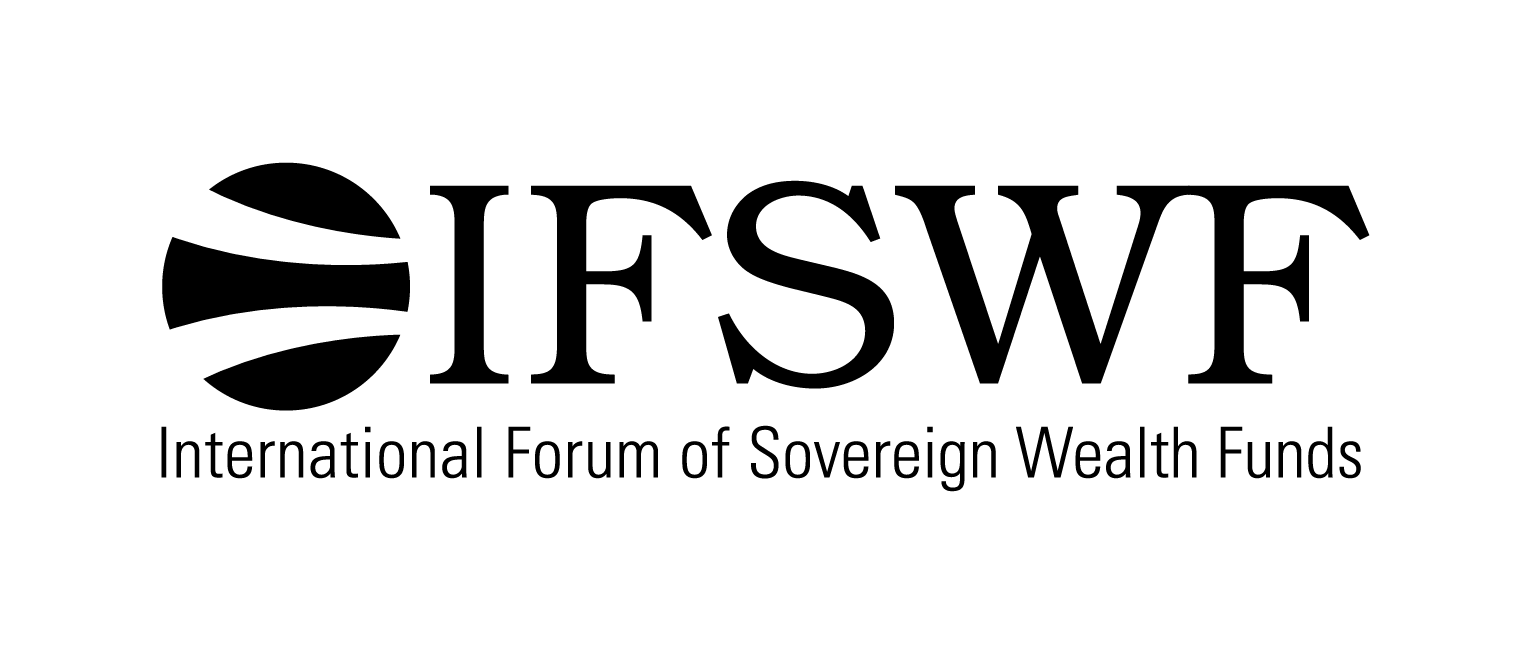
In 2016, the International Forum of Sovereign Wealth Funds (IFSWF) requested each of its member institutions to complete a self-assessment of their implementation of the Generally Accepted Principles and Practices (GAPP, or Santiago Principles) adopted by members of the IFSWF. These Principles address issues pertaining to legal and governance structures, organisational design, and operational practices. A review of the self-assessments reveals the breadth and depth of diversity across member countries and funds. While there are common structures and approaches to applying the Santiago Principles, no single model – or even small cluster of models – emerges from the reports. Rather, the self-assessments reflect local traditions, particularly in terms of legal and governance structures.
A review of the self-assessments reveals the breadth and depth of diversity across member countries and funds. While there are common structures and approaches to applying the Santiago Principles, no single model – or even small cluster of models – emerges from the reports. Rather, the self-assessments reflect local traditions, particularly in terms of legal and governance structures.
Despite this diversity, there are some clear themes that emerge in structures and approaches to implementation across funds and countries. Here we identify and highlight some of those themes and offer specific illustrations from the self-assessments.
We have organised this analysis into the three pillars consistent with those in the GAPP. Pillar I addresses the legal framework and objectives of funds, as well as how they coordinate investment activities with macroeconomic policies. Pillar II defines the institutional framework of a fund, as well as governance structures. Finally, Pillar III concentrates on the investment and risk framework of funds.
Pillar I: Legal Framework, Objectives, and Coordination with Macroeconomic Policies
Legal Framework
Most IFSWF members report being organised as one of three legal frameworks: A presidential, ministerial, or sovereign decree; an act of a legislative body; or other legislation, such as laws related to fiscal or budgetary matters or the management of natural resources. For example, the Fundo Soberano de Angola, the State Oil Fund of Azerbaijan (SOFAZ), Morocco’s Ithmar Capital, Oman’s State General Reserve Fund (SGRF), and the Qatar Investment Authority (QIA) were all established under a form of presidential or sovereign decree. Formal legislative acts also provide the legal foundation for Australia’s Future Fund, Alberta’s Heritage Savings Trust Fund (HSTF), the Abu Dhabi Investment Authority (ADIA), the Korea Investment Corporation (KIC), the New Zealand Superannuation Fund (NZSF), the Nigeria Sovereign Investment Fund (NSIA), and Trinidad-Tobago’s Heritage and Stabilization Fund (HSF) and the Russian Direct Investment Fund. In Chile and Mexico funds were established under legislation governing fiscal or budget functions. In Timor-Leste, the legal structure of its Petroleum Fund is detailed in the Petroleum Law.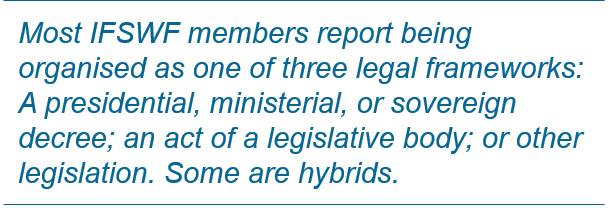
However, several funds have a hybrid or alternative legal structure, including those resulting from administrative or ministerial actions. The National Development Fund of Iran (NDF), for example, was established under a specific article of Iran’s Fifth Five-Year Development Plan. The legal foundation of the Ireland Strategic Investment Fund (ISIF) is established through Ireland’s National Treasury Management Act.
In Kazakhstan, which has two member funds, Samruk-Kazyna (SK) was established by decree, while the National Investment Corporation (NIC), was established under local company law as a subsidiary of the National Bank of Kazakhstan. Kazakhstan’s case is relevant as it reflects the relevance of both legal tradition and the role or function of the fund as informing modes of implementation of the GAPP.
In many cases, the nature of a fund’s legal framework also establishes its legal status, i.e. if it enjoys separate legal status as corporate entity or functions without separate status as an “account” or trust entity. Further details on legal status can be found below in the discussion on governance structures under Pillar II.
Here it is useful to note a general alignment of structure and mandate: Funds with an economic development or strategic mandate are often organised under local company law as corporations with separate legal identities. These include Ithmar Capital, the Palestine Investment Fund (PIF), and Samruk-Kazyna. To the extent that such entities serve as holding companies for state operating assets, separate legal status is useful – if not required – to permit these funds operating flexibility, including the ability to raise capital in international debt markets.
Diversity of Mandates and Key Fund Objectives
A key focus of the GAPP is the fund objective. The self-assessments reflect a wide range of fund mandates and objectives. Broadly, these conform to a conventional sovereign wealth fund typology.
- Fiscal stabilisation: Mexico’s Budgetary Income Stabilisation Fund (BISF) for example has a clear mandate to support macroeconomic stability by managing the fiscal impacts of resource price volatility.
- Intergenerational savings: Savings funds have a mandate to preserve and grow wealth for the benefit of “future generations” – a long-term savings function. Alberta’s HSTF, Oman’s SGRF, and the Alaska Permanent Fund (APF) are noted examples.
- Pension reserve: Australia’s Future Fund and the New Zealand Superannuation Fund both are designed to fund future retirement liabilities and are examples of funds with pension reserve mandates.
- Economic development: Most sovereign wealth funds have discrete commercial or financial objectives. However, some indicate an emphatic policy objective to promote economic development and diversification, including investment in local infrastructure. Funds with a clearly articulated economic development mandate include the ISIF in Ireland, Samruk-Kazyna, Ithmar Capital, the Palestine Investment Fund, and RDIF. The latter is also unique in reporting that its purpose is to execute its mandate within a fifteen-year period.
- Reserves management: Reserve management is sometimes cited as an objective of sovereign funds. NIC’s mandate involves managing the alternative assets held among Kazakhstan’s foreign reserves.
- Hybrid mandates: Several funds have multiple or hybrid mandates. Most common is a dual stabilisation and savings mandate, as the case with Angola’s Fundo Soberano, SOFAZ, Botswana’s Pula Fund, and the HSF in Trinidad and Tobago. Other IFSWF members isolate mandates using discrete sub-funds, like the Nigeria’s NSIA, which has three sub-funds focused discretely each on stabilisation, savings, and investment in local infrastructure. Chile, in fact, has two funds with distinct mandates. These are respectively for stabilisation and the management of pension reserves.
Institutional Integration with National Economic Policy Framework
The GAPP state clearly that where sovereign wealth fund activities have “significant direct domestic macroeconomic implications” these should be coordinated with domestic fiscal and monetary authorities. To implement this principle, funds tend to focus on the size and materiality of investment impacts on their economies. Generally, members take one of two approaches. The first is to report no direct and material macroeconomic impacts due to the size of the fund and the scale of domestic investment. 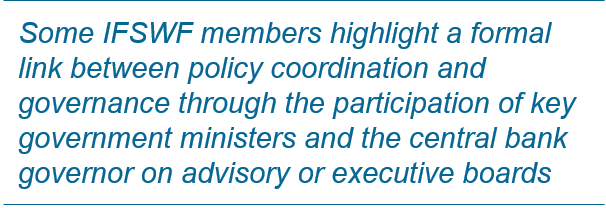 Alberta’s HSTF, Botswana’s Pula Fund, China Investment Corporation (CIC), Korea’s KIC, the Russia Direct Investment Fund, among others – report in this way.
Alberta’s HSTF, Botswana’s Pula Fund, China Investment Corporation (CIC), Korea’s KIC, the Russia Direct Investment Fund, among others – report in this way.
The second is to identify the fund’s investment activities as either directly or indirectly affecting near-term or long-term macroeconomic performance. Several funds with stabilisation or development mandates, such as SOFAZ, the NSIA, the ISIF in Ireland, Ithmar Capital, and the Palestine Investment Fund implement in this fashion.
Lastly, some member funds also highlight a formal link between policy coordination and governance through the participation of key government ministers and the central bank governor on advisory or executive boards of the funds. Angola’s Fundo Soberano, Iran’s NDF, Morocco’s Ithmar, and Nigeria’s NSIA are noted examples.
Funding and withdrawal mechanisms
Provision for withdrawals from sovereign wealth funds to support fiscal programmes or other initiatives of public investment or economic development is often linked to a fund’s operating objective. Most funds’ capitalisation and withdrawal mechanisms are outlined in their founding decrees or legislation, and thus publicly disclosed. This is the case for Chile, KIC in Korea, Ithmar, and Oman’s SGRF. Both pension reserve funds – from Australia and New Zealand – also have specified withdrawal policies. Several funds, particularly those funded by resource revenues like Alaska’s APF, report discrete funding and withdrawal metrics, including restrictions against withdrawing other than investment earnings.
Coherence and Scope of Executive Reporting to Asset Owner
Reporting is an important element of the GAPP. The scope of reporting extends from the primary shareholder of the fund to key stakeholder, and ultimately – in prescribed cases – to the public. The theme of reporting returns in Pillars II and III below. For Pillar I, reporting relates to sharing relevant statistical data with the owner. The self-assessments are quite detailed on matters of reporting, particularly those related to the owner. All reports highlight the scope and extent of reporting coverage to fund owners. Many extend to include detailed references to information reported to various government ministries, including central banks. Additional references include information reported directly to the public via national gazettes, the general media, and directly via fund websites.
Pillar II: Institutional Framework and Governance Structures
Nature and Role of Owner
Many self-assessments stipulate that governments own their funds. However, there is significant variation in the how ownership is structured. For example, in many countries including Australia, Botswana, Alberta, Ireland, Italy and Timor-Leste, the Finance Ministry or national treasury is responsible for the fund and carries out ownership functions. On the other hand, the governments of Angola, Azerbaijan, and Qatar execute the ownership function through their individual heads of state. Others, like Iran, have fund ownership vested in Parliament.
Some funds have unusual ownership structures. For example, the people of Palestine, as shareholders of the PIF, are represented by a General Assembly, which is comprised of 30 individuals experienced in business, academia, and regulation and appointed by the Palestinian President. The owners of the Nigeria Sovereign Investment Authority are represented by a Governing Council, whose membership includes the President of Nigeria, the governors of Nigeria’s 36 states and representatives of academia, civil society and Nigeria’s youth.
The role of the owner in fund management and operations is closely linked to the ownership structure. In general, governments tend to maintain passive oversight over the activities of their funds, leaving the asset management and allocation functions to a separate institution. Many of the self-assessments re-affirm this separation of the ownership and management functions of the funds.
Governance Structure
Governance structures vary significantly across the funds. A large majority are independent legal corporations, while several others – ISIF in Ireland, Mexico’s BISF, Rwanda’s Agaciro Development Fund (AGDF) – are managed by a board of trustees. Governance frameworks for trusts and corporations can be substantially different. For example, a trustee’s responsibility is to administer the trust assets for the benefit of the trust’s beneficiaries. Directors of a corporation might act in the interests not only the corporation but also its shareholders and other stakeholders.

The reports also reveal various unique fund structures, which are neither corporations nor trusts. For example, the Timor-Leste Petroleum Fund is established as an account of its Finance Ministry maintained with the Banco Central de Timor-Leste. RDIF is organised as a common-law mutual fund with a general partner, while Alaska’s APF is constituted as a pool of funds owned by the State of Alaska with no distinct legal identity or organisational structure.
In many self-assessments, there is some identification of the relationship between the owner and the governing board, and between the governing board and the manager. The owner typically appoints the governing board members and may be required to represent the owner’s or beneficiaries’ interests. For example, the governing board of the Iran’s NDF is the Board of Trustees, which is comprised of cabinet ministers and members of Parliament. Similarly, the governing body of SOFAZ consists of the country’s prime minister and other cabinet ministers. In these cases, the owner is represented on and has direct influence over, the fund’s governing body.
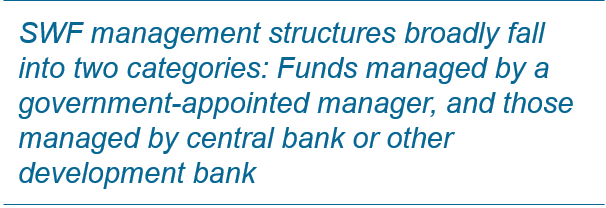 In other cases, the governing bodies are subsumed under the organisational structure of the fund (as, for example, the boards of directors of Ithmar and KIC). In many instances, the relationship of the governing body with the owner and/or the manager (including the manner of appointment of governing bodies) is stipulated in the law governing the fund. Here examples include Australia’s Future Fund, SOFAZ, the HSTF from Alberta, and the NSIA in Nigeria among others.
In other cases, the governing bodies are subsumed under the organisational structure of the fund (as, for example, the boards of directors of Ithmar and KIC). In many instances, the relationship of the governing body with the owner and/or the manager (including the manner of appointment of governing bodies) is stipulated in the law governing the fund. Here examples include Australia’s Future Fund, SOFAZ, the HSTF from Alberta, and the NSIA in Nigeria among others.
Despite the diversity of fund objectives, governing bodies generally share overarching responsibility for investing and for supervising fund managers. For example, in Australia, the Board of Guardians of the Future Fund is responsible for investing the assets of the fund. The governing bodies of some funds – KIA and NSIA – are tasked with providing strategic guidance and direction to the funds’ managers. Some governing bodies, such as those of at the HSTF, Mexico’s BSIF, and New Zealand’s NZSF, have the responsibility of reporting to the owner/beneficiaries on the performance of the fund and its managers. In doing so, the governing bodies act as a conduit of information between the owner/beneficiaries and the manager. Exceptions to this general rule include China’s CIC, whose board of directors is required to report directly to the owner.
Management Structure
Fund management structures broadly fall into two categories: Funds managed by a government-appointed manager – such as Australia’s Future Fund Management Agency, the Guardians in New Zealand, Iran’s NDF, the KIA in Kuwait, and Singapore’s GIC – and those managed by central bank or other development bank (as in Botswana, Mexico, Timor-Leste, Trinidad and Tobago). This distinction arises from the significant differences observed in organisational structure and fund management. For example, in Mexico, the fund features a hybrid management structure where asset allocation decisions (relating to portfolio composition, withdrawals, the volume of investible funds) are made by the government and asset management is carried out by a federal development bank.
As with the distinction between the roles of owner and governing body, many of the self-assessments state that the funds appoint independent managers, which have distinct roles and responsibilities. In general, managers are required to execute the fund’s corporate strategy, achieve its targeted rate of return, and oversee day-to-day operations. However, there are cases when the governing body may take on an operational rather than a purely supervisory role. For example, the board of directors of Samruk-Kazyna is responsible for approving the budget of the fund, acquisition proposals, and increases in the fund’s liabilities. Similarly, the board of directors of the Fundo Soberano in Angola fund is responsible for administering the fund, with the chairman responsible for leading and coordinating the executive functions of the fund.
In some cases, manager and governing body duties are dispersed. This is the case with Chile’s sovereign funds. The state of Chile is the owner, but the General Treasury is the bearer of the resources. However, Chile’s Finance Ministry is responsible for defining how the funds are managed, drawing up investment policies and managers’ supervision. Similarly, although the Bank of Botswana has overall responsibility for management of the Pula Fund, the Ministry of Finance and Economic Development also plays a key role in strategic asset allocation and the determination of investment policies of the fund.
Fund managers may be appointed under statutory mandate (as in Australia, and Nigeria), through a combination of statutory mandate and administrative action (for example, in Chile, Italy, and Morocco), by the governing body (China and Kuwait), or by the fund’s shareholder or head of State (as is the case with Kazakhstan’s NIC, the Palestine Investment Fund, and Qatar’s QIA).
The GAPP also address the operational independence of fund managers from owners. Here implementation varies across members often for functional reasons. In the case of Abu Dhabi, for example, ADIA’s Managing Director is vested by Law (5) with financial independence, including the decision authority over investment proposals following review and analysis. In Kazakhstan, Samruk-Kazyna manages strategic state operated assets. As the sole shareholder, the government appoints Samruk-Kazyna’s CEO and board members. The ex officio chair of the board of directors is the prime minister of Kazakhstan and the government of Kazakhstan is required to approve operational aspects of the fund, including the sale of assets, annual financial statements, and long-term strategy.
Scope of Public Disclosure
Most IFSWF members disclose information publicly, although the scope, and manner varies. For example, Australia’s Future Fund publishes quarterly portfolio updates, providing details of the investment activity and performance of the fund. Rwanda’s AGDF also publishes regular updates on its financial status and plans, as well as publishing financial statements with the source of funds and returns from investment each quarter. New Zealand’s NZSF publishes an analysis of the drivers of value added along with an overview of portfolio activity during the year. It also makes monthly disclosures including a breakdown by asset class and geography of the fund’s portfolio and its ten largest equity holdings by value.
 Conversely, the Qatar Investment Authority has no legal obligation to make disclosures. The fund’s board of directors has the power to decide the time and extent to which more information on the fund’s financial orientation and position will be made publicly available. From time to time, senior executive management may make public comments on certain aspects of the fund’s operations or its principal operating subsidiaries, but there is no fiduciary or legal obligation to do so.
Conversely, the Qatar Investment Authority has no legal obligation to make disclosures. The fund’s board of directors has the power to decide the time and extent to which more information on the fund’s financial orientation and position will be made publicly available. From time to time, senior executive management may make public comments on certain aspects of the fund’s operations or its principal operating subsidiaries, but there is no fiduciary or legal obligation to do so.
Pillar III: Investment and Risk Management Framework
Compatibility of Investment Policy and Decision-making with Mandate
Most IFSWF members invest to maximise risk-adjusted returns subject to their investment policy. Because the primary objective of most funds is wealth management and growth, this objective is consistent with their mandate to grow the wealth of the fund. Several funds have a discrete economic or development mandate in addition to an objective to generate solid financial performance. Ireland’s ISIF, Italy’s CDP Equity, the RDIF in Russia, and the Palestine Investment Fund all share such a mandate, as does one of the sub-funds of Nigeria’s NSIA.
In the context of investment policy statements, many funds report geographic or other investment constraints. Funds generally reported that they are restricted either to investing domestically or abroad. ADIA, SOFAZ, Botswana’s Pula Fund, and Trinidad and Tobago’s HSF all have mandates to only invest internationally, while others – ISIF, CDP Equity, the RDIF and PIF – are tasked to make significant domestic investments. For them, the focus on domestic investments is consistent with their mandate to promote domestic economic growth. ISIF, for example, is required to maximise benefit to the Irish economy by allocating 80% of its capital to sectors that have a substantial impact on metrics as GDP growth, employment, and net exports. The fund’s mandate includes maximising the discrete value created by its investments while avoiding crowding out the opportunity for private capital to participate.
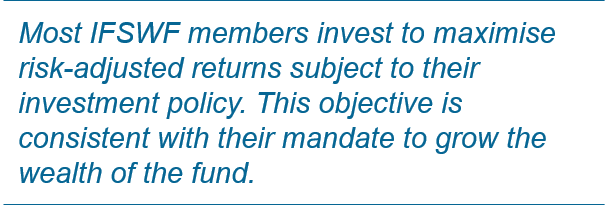
The use of derivatives is the most commonly restricted investment strategy amongst IFSWF members. Mexico’s BSIF and PIF in Palestine restrict the use of derivatives to hedging foreign currency exposures. Mexico’s Budgetary Income Stabilisation Fund, for example, is passively managed and is required to maintain high levels of liquidity. It hedges to reduce exposure to federal government revenues. The Palestine Investment Fund hedges against currency exposures in its highly liquid foreign asset portfolio. SOFAZ restricts derivative use to hedging or optimising currency composition and asset allocation. In the case of other funds – those in Botswana, Chile, and Iran – the use of derivatives by fund managers is more tightly circumscribed.
Many funds publicly disclose specific information related to their investment policy. The Future Fund, SOFAZ, ISIF, Italy’s CDP Equity, NZSF, RDIF, GIC, ADIA, and the Alaska Permanent Fund are all suitable examples. The nature of the disclosures ranges from general statements about investment policy to links to the full investment policy statement and associated legislation. Many funds also include their investment policy statement in their annual report.
Policies Concerning Ownership and the Exercise of Shareholder Rights
Most funds exercise voting rights directly as shareholders for economic and financial reasons. Of these funds, the Future Fund, CIC, NZSF, the RDIF, and Alaska’s APF each share publicly how they exercise shareholder rights. ADIA reports that it does not exercise voting rights unless it believes it must protect its financial interests or those of shareholders as a body. SOFAZ and Chile’s SWFs indicate that they do not exercise shareholder rights or they take a neutral position. Mexico’s BSIF and PIF in Palestine do not have shareholder policies. In Trinidad and Tobago, the HSF does not disclose its policy, while Botswana and Nigeria’s sovereign funds rely on their external managers to exercise voting rights by proxy.
Organisation and Execution of Risk Management Function
Most funds publicly report on risk management at least annually. Otherwise, the self-assessments exhibit little consistency in the implementation risk management processes identified in the GAPP. Some funds describe the risk function in the context of their operational structure. Others discuss overall risk management goals, some their risk mitigation and monitoring structures, while others simply acknowledge having risk management guidelines.
If a sovereign fund has not developed an in-house risk management department, their custodian may undertake this function. Botswana’s Pula Fund, Chile’s funds, the Timor-Leste Petroleum Fund, and the HSF from Trinidad and Tobago each report having some elements of risk management delegated to the custodian of the fund. Funds with internal risk-management teams typically report a hierarchical structure, where the risk management department reports directly to the executive management team or the board of directors. Several funds report using external platforms or frameworks as part of their risk management function. Kazakhstan’s NIC and Oman’s SGRF provide further details and identify their risk platforms.
Scope of Performance Reporting
There is also little consistency in how the funds report performance. All the funds report their performance to their owners. Funds prepare performance reviews at least annually. Several funds also report monthly and quarterly. The NZSF and the Chilean Funds, for example, report monthly, quarterly, and annually. The Iran’s NDF reports biannually. While all the funds report performance to their owners, several funds – the Future Fund, SOFAZ, CIC, KIC, NZSF, PIF, AGDF, and the Alaska Permanent Fund – publicly report periodic investment performance. The NZSF publishes monthly performance returns on its website. Other funds distribute performance data through their annual reports.
